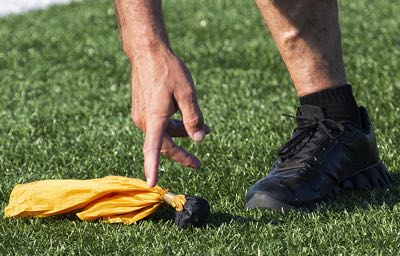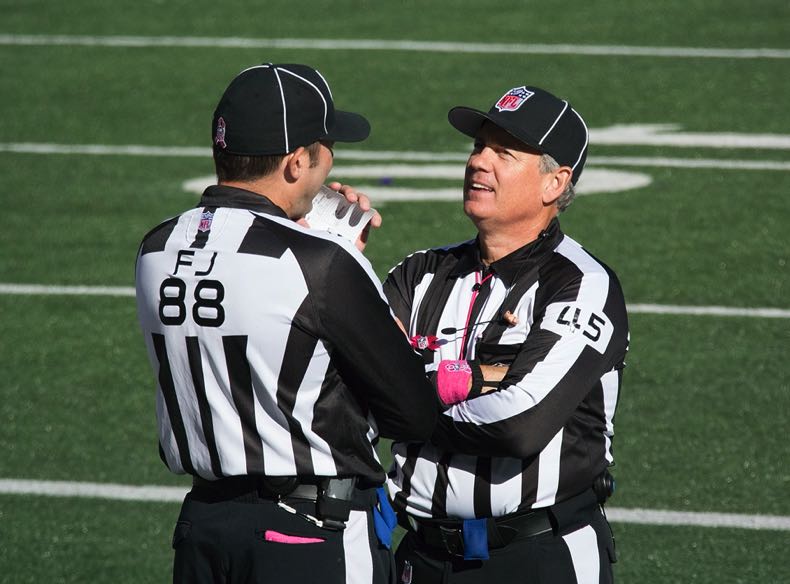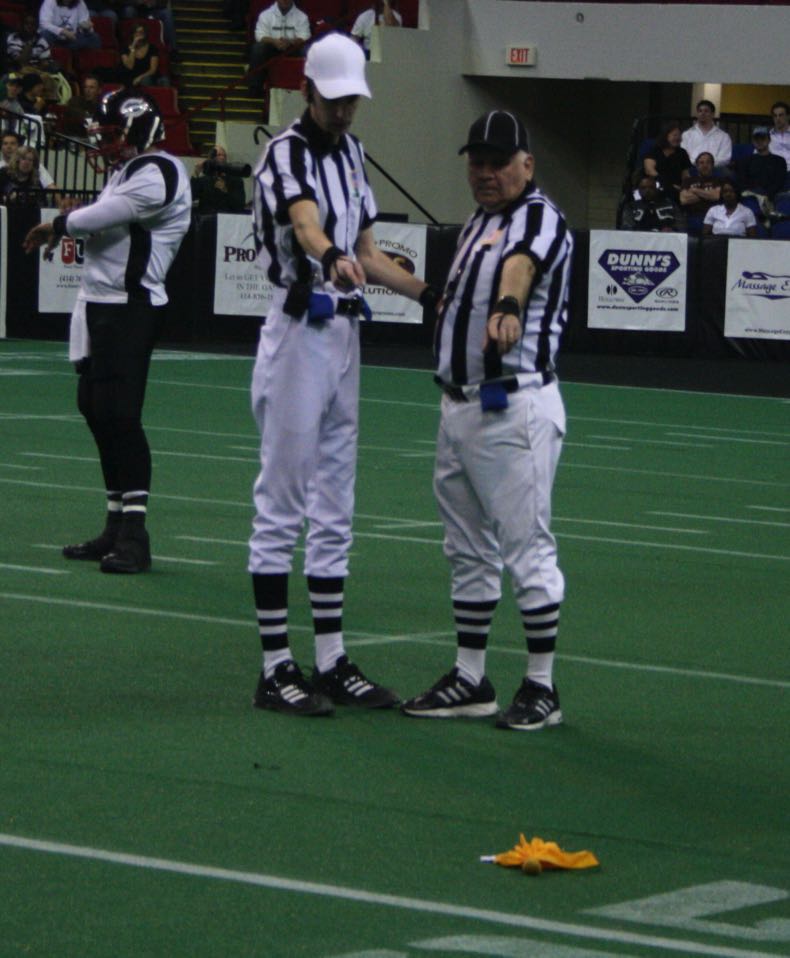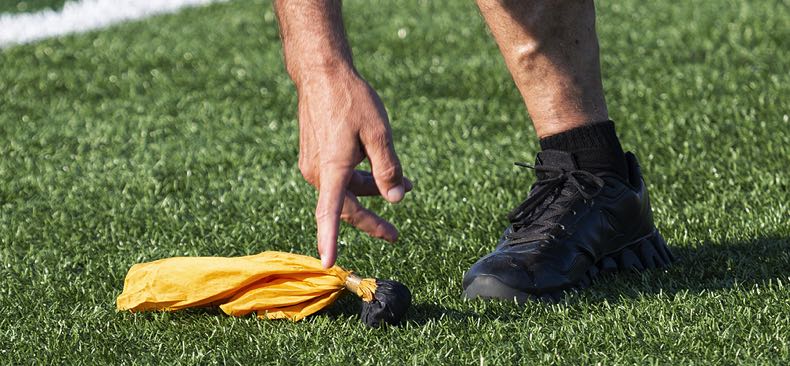 Most sports have lots of rules but – at least to the untrained eye – American football has more than most. Given the number of possible infringements and the complex and often frenetic nature of the plays, it is no surprise that professional American football matches have to have plenty of official eyes on the action. Indeed, there are a total of seven officials on the field of play in an NFL match, which we’ll detail below.
Most sports have lots of rules but – at least to the untrained eye – American football has more than most. Given the number of possible infringements and the complex and often frenetic nature of the plays, it is no surprise that professional American football matches have to have plenty of official eyes on the action. Indeed, there are a total of seven officials on the field of play in an NFL match, which we’ll detail below.
The main aim of this article, however, is to explain what a penalty flag is in American football. We’ll do this with a focus on the NFL, and as well as detailing what it is, we’ll explain when (and how) it’s used in a match.
What Officials Are There in an NFL Match?

Keith Allison / Wikipedia.org
As mentioned, in the NFL there are seven on-field officials. Though they are sometimes referred to referees, this is technically not correct as only one of the seven officials is actually called a referee. He’s the only one of the officials who wears a white cap (the other six wear black caps). All the officials wear shirts with black and white vertical stripes.
Note that further details about the specific roles, responsibilities and positions of the on-field officials can be found at the NFL Operations site, including a handy diagram. But here’s a brief rundown of the main responsibilities of each of the on-field officials:
Referee
The head official, the referee is positioned in the offensive backfield around 15 yards back and slightly to the right and is responsible for overseeing the officiating of the match. He will communicate fouls (verbally and with hand signals), determine the correct measurement of first downs when necessary and has the final say on disputed rulings. He also has the responsibility of counting the number of offensive players on the field to ensure there aren’t too many.
Umpire
Positioned in the offensive backfield along with the referee, but usually slightly to the left, the umpire’s main responsibilities include reviewing players’ equipment to ensure it fits within regulations, engaging with and advising players during the game to ensure the game remains under control, counting the number of offensive players on the pitch, marking off the penalty yardage and determining which player or team has possession of the football after a fumble has taken place.
Down Judge
Positioned on the sideline and looking along the line of scrimmage, the down judge watches for any offsides or encroachments, assesses and rules on sideline plays on his side of the field, and informs the referee of the current down.
Line Judge
Positioned on the opposite sideline to the down judge and also looking along the line of scrimmage, the line judge essentially has the same main responsibilities (with sideline calls on his side of the field), though he doesn’t need to inform the ref about what down it is.
Field Judge
Positioned in the defensive backfield, 20 yards behind the line of scrimmage and on the same sideline as the line judge, the field judge looks for illegal use of hands and blocking fouls on the part of the receiver(s) on his side of the field. He also looks for any fouls made by defensive players covering the receiver. He also keeps an eye on the sideline to assess when players go out of bounds and counts the defensive players on the field to ensure there are not too many.
Side Judge
Positioned in the defensive backfield some 25 yards back from the line of scrimmage, the side judge stands on the same sideline as the down judge. His responsibilities include being the main timekeeper in the event the match clock stops working for whatever reason, and he also checks for infringements on the part of or against the receiver(s) on his side of the pitch and checks for players going out of bounds.
Back Judge
Positioned in the deep backfield, usually 30 yards behind the line of scrimmage and midway between the sidelines, the back judge is responsible for keeping track of the 40- and 25-second game clocks and for managing TV breaks. He also counts the defensive players to ensure the correct number are on the field of play.
Note that the positions and responsibilities of the various officials change depending on what kind of play is taking place and where the line of scrimmage happens to be.
So, What About the Penalty Flag?

Jeramey Jannene / Wikipedia.org
You might be wondering why we haven’t gone into detail about the flag yet, which would be fair enough. But we thought it pertinent to run through the main duties of the on-field officials so that the usage of the penalty flag could be explained in context. Let’s examine what the flag is and when it’s used in NFL matches.
A Yellow Cloth that Indicates an Infringement
In a literal and physical sense, the penalty flag in NFL is simply a piece of yellow cloth that is weighted in some way (so it doesn’t just float away). In the context of an NFL match, yellow flags are used to indicate when an infringement has occurred (or has been perceived to have occurred). The reason the official in question doesn’t just blow his whistle is that it would be very difficult to ascertain which official had spotted the infringement, whereas the visual quality of a bright yellow flag is rather easier to recognise in the heat of a game.
Flag Is Thrown by Official
When one of the officials spots an infraction, they throw the flag towards the area in which the incident took place. Often more than one of the abovementioned officials may spot an infringement and so more than one flag could be thrown. As they only have one flag, if one of the officials spots more than one infringement, once they have thrown their flag for the first instance, they can throw either a bean bag or their cap towards the point of the second infringement.
Does Not Automatically Stop Play
Note that the throwing of a flag does not automatically stop the play and it is only when the ball is dead (for instance it goes out of play) that the referee will deal with the alleged incident. When play has stopped, the referee will generally confer with the official(s) who threw the flag, sometimes also seeking advice from other officials who may have seen the incident in question. The referee will then make a ruling about what fouls have been committed and what penalties will be dished out to the offending team or player. The ref will give verbal and physical signals outlining the decision(s) he’s taken.
Types of Infringements & Penalties in American Football

Now we know what the flag is, let’s take a look at some of the main infringements that cause the flag to be thrown. We’ll also outline the penalties that can be dished out by the referee once it has been confirmed that a player or a team has broken the rules of the game. Note the details given are based on the NFL rules and may differ in other American football leagues, formats or competitions.
Most Common Infringements in the NFL
- Block in the Back – A rather self-explanatory foul, a player makes contact with a player from the other team who, crucially, is not in possession of the football. The contact is from behind and above the waist and results in a 10-yard penalty.
- Delay of Game – Akin to timewasting in soccer, this infringement relates to any act that delays the next play unfairly. This results in a 5-yard penalty.
- Encroachment – Similar to offside (below) in that a player crosses the line of scrimmage before the snap, but encroachment is called if they either make contact with a player from the other team or they have a clear path to the other side’s quarterback. A 5-yard penalty is awarded as a result.
- False Start – This occurs when a player from the offensive team moves after lining up for the snap but before the snap occurs. It results in a 5-yard penalty.
- Holding – Perhaps the most common of all infringements, this occurs when a player grabs or pulls a player from the other side (who isn’t in possession of the football). If the foul has been committed by the offensive team, a 10-yard penalty is awarded, while it is just a 5-yard penalty if committed by the defensive side.
- Too Many Players on the Field – Also known as illegal participation, this simply refers to one of the sides having more players on the field than is allowed and results in a 5-yard penalty.
- Offside – This occurs, in basic terms, when a player is the wrong side of the line of scrimmage at the snap. A 5-yard penalty results.
- Pass Interference – This is when a player makes contact with a would-be receiver after a pass has been made but before the receiver in question has touched the ball. This results in an automatic first down being awarded to the other side (if the infringement was made by the defending team), or a 10-yard penalty if made by the offensive side.
- Roughing – When roughing the passer, the infringement involves tackling or “hitting” the other team’s player after they should, i.e. after that player has either passed or kicked the football. This results in a 15-yard penalty and an automatic first down (if committed by the team on defense).
- Personal Foul – Usually some kind of violent conduct or “unnecessary roughness” towards an opponent, such as piling on a player who is already down, hitting a player who is out of bounds or some other contact that is deemed to be a little over the top in terms of the level of physicality. This results in a 15-yard penalty and automatic first down if committed by the defense and players can be ejected (sent off) from the game if they are deemed to have performed a particularly dangerous or violent foul.
There is an extensive list of other infringements that would generally cause at least one of the officials to toss their flag. There are so many possible ways to break the vast array of NFL rules that to go into any more detail would make this a very long article indeed. But in case you are keen to read about the many other possible infringements, check out the full NFL Rulebook.
Penalties Awarded for Infringements
In most cases, an infringement will result in a yardage penalty, i.e. the line of scrimmage will be moved a certain number of yards (usually 5, 10 or 15) in favour of the team against whom the foul/infringement was committed. In some cases, mainly in the case of defensive fouls, an automatic first down is awarded to the offensive side, though in other cases the current down is simply replayed. As mentioned, in certain circumstances, individual players can be ejected from the field of play.
Penalty Flag Conclusions
The penalty flag is an important part of American football in that it quickly shows other officials, commentators and fans that some kind of infringement has been spotted. Unlike with soccer, when a whistle is blown or – in the case of the linesmen – a flag is waved, in the NFL, the penalty flag is thrown to the point where the foul was committed (or as near as possible to it).
At times, such as when multiple officials flag the same incident, it can seem like some kind of kids’ party, with flags, beanbags and hats flying here and there; but, in general, the system works well. Which is just as well in a sport with so many rules and possible infringements.
